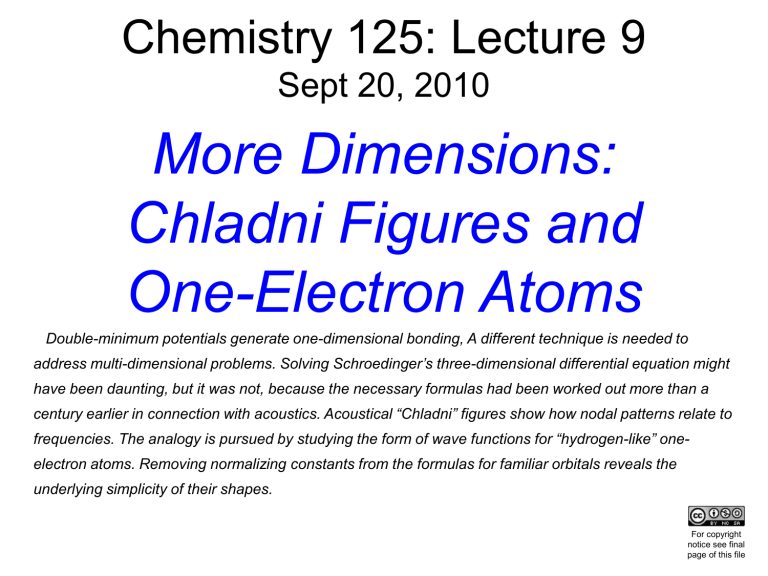
Chemistry 125: Lecture 9
Sept 20, 2010
More Dimensions:
Chladni Figures and
One-Electron Atoms
Double-minimum potentials generate one-dimensional bonding, A different technique is needed to
address multi-dimensional problems. Solving Schroedinger’s three-dimensional differential equation might
have been daunting, but it was not, because the necessary formulas had been worked out more than a
century earlier in connection with acoustics. Acoustical “Chladni” figures show how nodal patterns relate to
frequencies. The analogy is pursued by studying the form of wave functions for “hydrogen-like” oneelectron atoms. Removing normalizing constants from the formulas for familiar orbitals reveals the
underlying simplicity of their shapes.
For copyright
notice see final
page of this file
Reward for Finding Y
Knowledge of Everything
e.g.
Allowed Energies
Structure
Dynamics
Bonding
Reactivity
@ 1.3Å
@ 0.6Å
For
Hooke's
Law
Actually
Singlevs.
Double
Minimum
the
Blue Energy
this is a
is too Low
DoubleBoth are
and
Minimum.
~ same as
single-minimum
the Red Energy
solution
is too High.
The Blue and Red
Ys are correct!
Single-Mimimum
“Splitting”
The
Correct
Lowest
What
if wells give
Closer
Energy
must lie
thelowered
wells
were
minimum energy
between
further
apart?these
and
raised
secondvalues.
energy
"Mixing" localized Y s for double minimum
in A
Wells far
apart
increased curvature
lower Kinetic Energy!
reduced curvature
in AB
Stabilization
of Particle
Total Energy of Particle
For bonding
between
3D coulombic atoms, see Lecture 12.
Black line
is energy
Blue line is Y
in B
Wells far
apart
Holds
Wells close A & B
together together
Dynamics:
Tunneling
Dynamics:
Tunneling
Negative
Kinetic
Energy
The word "Tunneling" is one of my pet peeves:
It is misleading and mischievous because it suggests that there is
something weird about the potential energy in a double minimum.
In fact it simply involves the same negative kinetic energy
that one sees in the tails of EVERY bounded wavefunction.
The word reveals naiveté about quantum mechanics.
Dynamics:
Tunneling
-14 sec
510
Well-to-Well time
Assertion : based on
Splitting (kcal/mole)
time-dependent quantum mech.
1.4 kcal/mole ~ 410-14 sec to get from well to well.
splitting
Reward for Finding Y
Knowledge of Everything
e.g.
Allowed Energies
Structure
Dynamics
Bonding
Reactivity (coming later)
"Erwin" can
Don’t slope out and away from
find
Ys for any complicated
Y = 0 in “forbidden” continuum.
V(x)
Morse
Quantization
and rank them
by energy
/ "curvature" / # of nodes
Why is
this Y not
satisfactory?
Don’t cross 0 in “forbidden” continuum.
7Å
“Erwin”
even
handles
Multiple
Minima
When there are many curvatures, it is not clear
how to partition the kinetic energy among
the different (d2Y / dxi2) / Y contributions.
Unfortunately:
Erwin’s curve-tracing recipe
won't work in more dimensions
(e.g. 3N).
But Schrödinger had no trouble finding
solutions for the 3-dimensional H atom,
because they were familiar from a long
tradition of physicists studying waves.
Acoustics (1803)
e.g. Chladni Figures
E. F. F. Chladni
in 2 Dimensions
(1756-1827)
Sand
Collects
in Nodes
Touch in
Different
Places
Bow in
Different
Places
dry
ice
brass plate
CO2
Click for Short Chladni Movie (3MB)
Click for Longer Chladni Movie (9.5MB)
3 Circles
3 Diameters / 1 Circle
Crude Chladni Figures
1 Diameter / 2 Circles
4 Diameters / 1 Circle
from
in-class demo
Chladni’s
Nodal
Figures
for a
Thin Disk
(1,2)
Portion inside outer circular node
Cf. http://www.kettering.edu/~drussell/Demos/MembraneCircle/Circle.html
Chladni’s
Nodal
Figures
for a
Thin Disk
Number of Diametrical Nodes
Number of Circular Nodes
PITCH
47 Patterns!
"These pitch relationships agree approximately
with the squares of the following numbers:"
1 Circle
Number of Circles
4 Circles
2 Lines
Number of Diameters
3 Circles
2 Lines
2 Circles
4 Lines
1 Circle
6 Lines
8 Lines
Frequency ≈ (Diametrical Nodes + 2 Circular Nodes) 2
Note: Increasing number of ways to get a higher frequency
by mixing different numbers of circles and lines
Great Mathematicians Worked
on Chladni’s 2-D Problems:
e.g.
Daniel
Bernoulli
(1700-1782)
2/x2 + 2/x2 + 2/x2
(abbreviated 2)
the Laplacian Operator
Ys for one-electron atoms
involve
Laplace’s
“Spherical Harmonics”
(3D-Analogues of Chladni Figures)
3-Dimensional H-Atom Wavefunctions
Y (,,) = R(r) ( ) ( )
R(r) are the normalized
“Associated Laguerre Polynomials”
() is the normalized
“Associated Legendre Function”
with contributions from other
old-time mathematicians
Edmond Laguerre
Adrien-Marie Legendre
(1834-1886)
(1752 -1833)
Y Table for H-like Atoms
1
V(x,y,z) =
sqrt(x2 + y2 + z2)
Y(x,y,z) is very complicated
z
change
coordinate
system:
r
e
x,y,z r
n
x
y
c
simplifies V(r,,) =
r
and
Y = Rnl(r) lm() m()
product of simple functions
of only one variable each
Name Y by
quantum numbers (n > l ≥ m)
or by nickname (1s, etc.)
Y Table for H-like Atoms
Y = R(r) () ()
z
r
n
)3/2
x
e
y
Note: all contain (Z / ao
-/2
Squaring gives a number,
N.B.
Nounit
surprise
for
Z 3 per
volume
Why instead of r?
Coulombic
Potential
(units
of probability
density)
2Z r
nao
Allows writing the same e-/2
for any nuclear charge (Z)
and any n. >1e/Å3!
1s = K e
Q: How much less dense is 2s at nucleus? e-density at H nucleus ( = 0)
(1sH ~2 e/Å3)
All-Purpose Curve
-
exp
shrunk by Z; expanded by n
Increasing nuclear charge
sucks standard 1s function
toward the nucleus
1/6
(renormalization keeps
total probability
constant)
nao
r=
2Z
r1H =
r1C =
216
0.1(1s0.2
Å (1sC) Å
C)
Different Å scale
scales
Common
2Z r
nao
0.5
0.1
0.53Å
2
(0.26 Å)
0.53Å
12
(0.044 Å)
1.0
0.2
Å (1sH)
Summary
Electron Density (e/Å3)
400
1sC(0) is 216 times 1sH(0)!
2Z r
nao
300
Increasing nuclear charge
sucks standard 1s function
toward the nucleus
200
(renormalization keeps
total probability
constant)
What would the
exponential part
+5
of…….
C2s
look like?
(but smoothed by vibration)
+5
C1s
100
2
0.1 0.2
Common Å scale
H1s
0.5
1.0
For Wednesday:
1) Why are there no Chladni Figures
with an odd number of radial
nodes? (e.g. 3 or 5 radii)
2) Why are the first two cells [(0,0) and
(1,0)] in Chladni's table vacant?
3) Compare 1sH with 2sC+5 in Energy
4) Do the 6 atomic orbital problems
Click Here
Y Table for H-like Atoms
Shape of H-like Y
z
r
r cos() = z
e
n
x
y
-/2
=
K
e
1s
2
Simpler (!) than Erwin 1-D Coulombic
2s = K'(2-) e-/2
Spherical node at = 2
2
2
-/2
2pz = K'''( cos(
z )) e
Planar node at z = 2
Guess what 2px and 2py look like.
The angular part of a p orbital
0.5
0.71
•
•
- 0.5
0.86
= ±90°
=±60°
= ±45°
=
±30°
= 0°
•
+
0
0.5
•
Polar Plot of cos(2() )[radius] vs.
•
0.5
•
•
-1
•
0.71
[angle]
0.86
1
2p Contour Plot
?
•
Polar Coordinates
e-/2 cos()
Find Max:
•
= 0
de-/2)/d
-e-/2/2 + e-/2
(-/2 + 1) e-/2
(max for C+6 = 14 e/Å3)
Exam 1 - Friday, Sept. 24 !
Session 1
10:15-11:15 Room 111 SCL
Session 2
10:30-11:30 Room 160 SCL
Extra Review/Help Session
Wednesday 8:00-10:00 pm
Room 119 WLH (McBride)
End of Lecture 9
Sept 20, 2010
(see Lecture 10 for description of Atom-in-a-Box)
Copyright © J. M. McBride 2009. Some rights reserved. Except for cited third-party materials, and those used by visiting
speakers, all content is licensed under a Creative Commons License (Attribution-NonCommercial-ShareAlike 3.0).
Use of this content constitutes your acceptance of the noted license and the terms and conditions of use.
Materials from Wikimedia Commons are denoted by the symbol
.
Third party materials may be subject to additional intellectual property notices, information, or restrictions.
The following attribution may be used when reusing material that is not identified as third-party content:
J. M. McBride, Chem 125. License: Creative Commons BY-NC-SA 3.0







